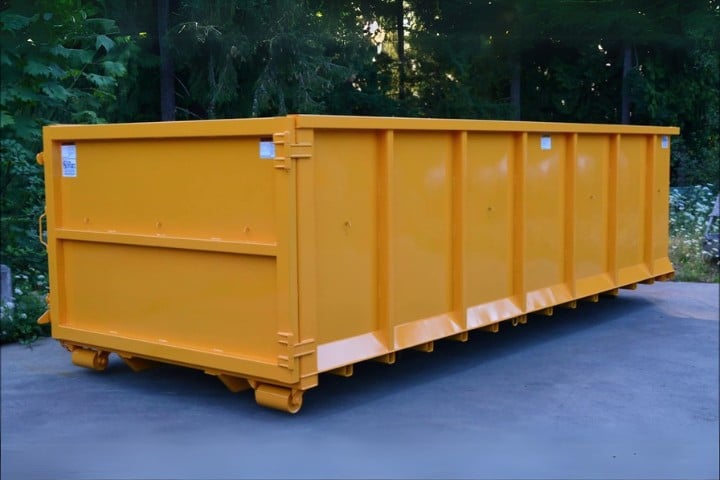By considering the amount and type of debris involved in a garage cleanout, most homeowners have opted for ten yards or so to tidy up their garage. The amount of space that unwanted items require in your garage will determine whether a smaller or larger container is necessary. If you have a significant amount of clutter or large items, size up can make disposal easier and save on additional trips.
There’s no need for you to make a guess about which dumpster to choose. Those contemplating roll-off dumpster rentals in NJ can find local sizes that are tailored to their requirements. Getting custom quotes simplifies the process of cleaning up your garage, making it less stressful and more manageable.

Important Factors for Estimating the Right Dumpster Size
To clean up a garage, it is important to consider the amount of material, items that must be discarded, and the differences in dumpster dimensions. Every step is crucial to avoid paying extra fees or running out of space.
Assessing the Dimensions of Garage Content
Initially, examine everything stored in the garage with great attention. Divide items into smaller groups, such as heavy objects, ruined tools, containers, and aged furniture. Take some measurements or notes to determine what is and is not included.
A good way to gauge volume is to visualize the number of pickup truck beds it would fit.’ Smaller cleanouts, such as a single-car garage filled with boxes and loose debris, may fill 3-4 truck beds. Larger cleanouts or those with a lot of bulky items may require more space.
Use this table to help visualize volume:
| Amount to Toss Away | Pickup Truck Loads | Estimated Dumpster Size (yd³) |
| Small pile (few items) | 1-2 | 6-10 |
| Standard garage cleanout | 3-5 | 10-15 |
| Multiple large items/boxes | 6-8 | 15-20 |
Keep in mind, packing dumpsters tightly also makes a difference.
Types of Debris Commonly Found in Garages
Keeping dumpsters tightly packed is also important.
Discarded waste materials are frequently observed in garages.
The garage is commonly filled with a mix of debris. Frequently, these items consist of old paint containers and pieces, as well as broken machinery, tires, gardening tools, furniture, kitchen equipment (such as drills or other appliances), cardboard, and scrap wood. The most common kind are in the recycling center.
Specific rules may be in place to manage specific debris, such as paint, chemicals, or electronics.. Dumpsters are not designed to hold debris like heavy machinery, broken concrete, or old gym equipment. This can cause weight issues.
Considering the weight and space of your garage when selecting a dumpster is crucial. Before reaching the top of a dumpster, it is possible for heavier materials to fill the container, while larger bags of trash or smaller particles require more space.
List of common debris types:
- Cardboard boxes, papers, and books
- Paint cans and solvents
- Broken bikes, toys, or tools
- Old shelving or cabinets
- Small appliances and electronics
Make a tally list before deciding on the size.
Dumpster Size Comparison and Recommendations
Dumpsters can be classified into different cubic yards, which are commonly used for a garage cleanout, such as 10, 15, or 20 yard sizes.
A 10-yard dumpster is a practical choice for tidying up small garages or disposing of large items. Three pickup truck loads are the approximate amount of space it can hold.
A 15-yard dumpster is the most common solution for cleaning a garage with only one vehicle. It can hold items such as boxes, small appliances, and old furniture from 4-5 pickup beds.
For two-car garage cleanouts, large clean outs and bulky items such as mattresses or shelving they are generally best suited for the 20-yard dumpster.
Here’s a comparison table:
| Dumpster Size (yd³) | Approx. Pickup Loads | Common Use Case |
| 10 | 3-4 | Small to medium garage cleanouts |
| 15 | 4-5 | Standard single-car garage |
| 20 | 6-8 | Two-car garage or bulky items |
Pick the size that matches both what you have and allows for any surprises found during the cleanout.
How to Select Practical Dumpsters for Homeowner Use
When selecting a dumpster size, it is important to factor in the quantity of waste you intend on disposing and your personal belongings as well as the standard rental procedures. Making sound decisions can help to prevent money-wasting and alleviate projections.
Estimating Space Requirements
To begin with, homeowners should examine everything in their garage that needs to be removed. Old furniture, boxes, or tools can quickly fill up space..
A 10-yard dumpster is a substantial size for cleaning up an ordinary garage, with room for around 50-70 large trash bags. However, it may not be practical to rent one. Two-car garages or rooms filled with heavy waste may require a 15 yard or 20 yards Dumpster for better storage capacity.
By measuring large quantities or preparing a brief inventory of what’s being transported, it can be easy to determine the required size. If you are uncertain, resize to the next size; it’s less complicated than needing a second dumpster at another time. The stacking efficiency of small items like boxes and bags is evident, whereas larger pieces require more space.
| Common Dumpster Sizes for Garage Cleanouts | Approximate Capacity |
| 10-yard | 50-70 large trash bags |
| 15-yard | 80-100 large trash bags |
| 20-yard | 110-130 large trash bags |
Avoiding Overfilling and Extra Fees
Maintaining a precise record of the dumpster’s capacity while loading is prudent. Waste should be disposed of at the designated “fill line” in most rental establishments.
Trucks cannot safely transport overfilled loads, which can result in overfilling and additional fees. Expenditures that exceed the weight limit may result in increased expenses, particularly for items like broken appliances or scrap metal.
Be sure to consult the rental agreement for any changes you may make, such as weight restrictions and fees. Put everything in the dumpster as evenly as possible and break down larger items, such as furniture, into smaller pieces if feasible.). It enhances the fit of your body and prevents pickup difficulties.
Coordinating Pickup and Drop-Off Schedules
Preparing delivery and pickup times in advance helps projects run smoothly. A suitable starting date should be established for homeowners to gather, organize, and load everything. This is crucial.
Requesting a drop-off time at least 24 hours before the start of your workday is beneficial. Pickup time should be scheduled shortly after the garage is empty, so there are no more rental days.
Many rental services provide extended time, but it may come with a higher price tag. However, for some reasons. Ensure that communication with the rental company is clear, as it helps to avoid charges for late arrivals or missed pickups. The driveway’s space is made more efficient through it.
Conclusion
Investing in the quantity and type of belongings in your garage is an ideal starting point for homeowners.
For a small cleanout, he may need merely ten yards of the 10 yard dumpster, or more for if you are doing some major work. It’s also helpful to be mindful of local regulations and dumpster boundaries. An etched strategy and an expedited appraisal of what to discard will facilitate the process. Picking a proper dumpster size is key to expediting and simplifying garage cleanup.
We hope you found this blog post on How to Estimate the Right Dumpster Size for a Garage Cleanout, useful. Be sure to check out our post on What is Commercial Dumpster Rental? for more great tips!
Have Experience in the Moving Industry? Want an Additional Income Stream? Work With All Around Moving!
Partner with us by establishing your own moving consultant business. Click here to learn more.




